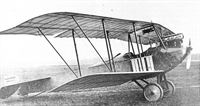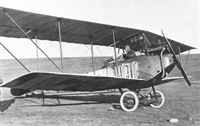
Описание
Страна: Германия
Год: 1913
J.Herris Aviatik Aircraft of WWI (A Centennial Perspective on Great War Airplanes 10)
Aviatik B - Type P14
Aviatik's next B-type design was a slightly smaller, more refined design, the P14 with 2 1/2-bay wings with 14.5 m span. Again the aircraft were of conventional construction and powered by a variety of 85-100 hp Argus, Benz, and Mercedes engines.
Aviatik B-Types in Combat
In 1914 the German army air service went to war flying Aviatik, Albatros, and LVG B-types and a melange of Taubes and other monoplanes and biplanes. Any aircraft, especially any reliable, robust aircraft, was highly valuable for reconnaissance and light bombing. The rigors of front-line service quickly weeded out types with limited potential like the Taubes, and the Aviatik, Albatros, and LVG B-types became the most numerous combat aircraft.
Aviatik B-types were known for reliability, robust structures, and load-carrying ability, and therefore formed the equipment of the first German bombing units. An Aviatik P14, B.114/14, was the first German aircraft downed in air-to-air combat (on October 5, 1914 by a French Voisin V pusher). Late historian Alex Imrie claimed Aviatik B.192a/13 was the first German aircraft armed with a machine gun for offensive purposes, and on April 28, 1915, an Aviatik flown by Hptm. Hugo Geyer and Oblt. Egbert Kuhn of Feld-Flieger-Abteilung 48 attacked and downed a Voisin pusher from a formation of three.
Aviatik B-types served at the front in quantity throughout 1915 and into 1916, although from late 1915 they were gradually replaced by armed C-type aircraft. Surviving B-types were then used for training.
Most early German aircraft were in plain finish of clear-doped linen with the early version of the iron cross national insignia. In many cases the insignia was painted directly on the fabric, while in others it was painted on a white background for contrast. Later the white background was reduced to a 50mm white outline.
Описание:
- J.Herris Aviatik Aircraft of WWI (A Centennial Perspective on Great War Airplanes 10)
- P.Grosz, G.Haddow, P.Shiemer Austro-Hungarian Army Aircraft of World War One (Flying Machines)
- E.Hauke, W.Schroeder, B.Totschinger Die Flugzeuge der k.u.k. Luftfahrtruppe und Seeflieger 1914-1918
- Журнал Flight
Фотографии
-
J.Herris - Aviatik Aircraft of WWI /Centennial Perspective/ (10)
Aviatik (P14) B.268/13 (original markings).
-
J.Herris - Aviatik Aircraft of WWI /Centennial Perspective/ (10)
Aviatik (P14) B.268/13 (later markings).
-
J.Herris - Aviatik Aircraft of WWI /Centennial Perspective/ (10)
Aviatik (P14) No.26, Swiss Air Service 1915.
-
J.Herris - Aviatik Aircraft of WWI /Centennial Perspective/ (10)
Aviatik B (P14) "15" at the Aviatik flying school at Leipzig-Mockau in October 1916.
-
J.Herris - Aviatik Aircraft of WWI /Centennial Perspective/ (10)
Aviatik B (P14) "15" at the Aviatik flying school at Bork in November 1917. The same aircraft as previous, it has been recovered, the rear cockpit turtledeck removed, and a revised exhaust fitted.
-
J.Herris - Aviatik Aircraft of WWI /Centennial Perspective/ (10)
Aviatik P14 B-type B 36/14 is readied for a reconnaissance mission early in the war. The pilot, Herman Goring, would later become a leading fighter ace and win the Pour le Merite, also known as the Blue Max. Unfortunately, he became a notorious Nazi leader post-war.
-
J.Herris - Aviatik Aircraft of WWI /Centennial Perspective/ (10)
Typical Aviatik P14 B-type. This photo was likely taken prewar due to the lack of insignia. Like all B-types, the pilot sat in the back seat to give the observer the best view forward and downward. The engine was a 100 hp Argus As.I cooled by side radiators. The wings have a slight sweepback, there are struts to the wingtips, and no fixed fin was fitted. (Aeronaut)
-
M.Dusing - German & Austro-Hungarian Aero Engines of WWI. Vol.2 /Centennial Perspective/ (65)
Ingold's Aviatik-Pfeil biplane record aircraft with 100 hp Mercedes.
-
Журнал - Flight за 1914 г.
Herr Karl Ingold and his 100 h.p. Mercedes Aviatik-Pfeil biplane on which he made his recent record flight.
-
Журнал - Flight за 1915 г.
One of the latest Aviatik biplanes, of which a considerable number are in use in the present war.
Aviatik P14 (B type) (1913) -
J.Herris - Aviatik Aircraft of WWI /Centennial Perspective/ (10)
Closeup of Aviatik P14 B-type 324/14; the pilot sat in the back seat to give the observer the best view forward and downward. The engine was a 100 hp Argus As.I.
-
J.Herris - Aviatik Aircraft of WWI /Centennial Perspective/ (10)
Typical Aviatik P14 with 2 1/2 bays of bracing. This aircraft uses a 100 hp Argus As.I engine.
-
J.Herris - Aviatik Aircraft of WWI /Centennial Perspective/ (10)
Pre-war Aviatik P14 B-type intended for use in the German colony known as German Southwest Africa. Early German aircraft were often called "Pfeil" (Arrow) if their wings were swept back, but this was not a formal designation.
-
J.Herris - Aviatik Aircraft of WWI /Centennial Perspective/ (10)
An Aviatik B-type, company designation P13, is in the foreground of this pre-war image of a flying competition. Aviatik soon earned a reputation for robust, reliable biplanes and 101 Aviatiks were ordered in 1913, a substantial quantity for this early period before the war.
-
J.Herris - Aviatik Aircraft of WWI /Centennial Perspective/ (10)
Typical Aviatik P14; like B.120/14 it has 2 1/2 bays of bracing.
-
J.Herris - Aviatik Aircraft of WWI /Centennial Perspective/ (10)
Aviatik P14 B.120/14 became well-photographed and well-known for being shot down on April 1, 1915, by French fighter pilot Jean Navarre for his first of 12 victories. This was also the first victory of Navarre's unit, M.S.12.
-
J.Herris - Aviatik Aircraft of WWI /Centennial Perspective/ (10)
Another view of Aviatik P14 B.120/14 shot down on April 1, 1915, by French pilot Jean Navarre (at left) and observer Roberts. Unlike most P14 aircraft, it has a fixed fin.
-
J.Herris - Aviatik Aircraft of WWI /Centennial Perspective/ (10)
Aviatik P14 B.120/14 in the background with the pilots of M.S.12; Navarre is second from left in the front row.
-
M.Dusing - German & Austro-Hungarian Aero Engines of WWI. Vol.2 /Centennial Perspective/ (65)
The Postage stamp showing Pilot Ingold and his LVG (???) biplane (100 hp Mercedes D I)
-
J.Herris - Aviatik Aircraft of WWI /Centennial Perspective/ (10)
Aviatik P14 B.120/14 with wings removed and Navarre in the cockpit is the center of attention at M.S.12.
-
J.Herris - Aviatik Aircraft of WWI /Centennial Perspective/ (10)
Aviatik hangar at Darmstadt with Aviatik P13 B-types.
-
P.Grosz, G.Haddow, P.Shiemer - Austro-Hungarian Army Aircraft of World War One /Flying Machines/
Ground crews rolling the Aviatik Av.16 to take-off position on the Flik 4 airfield at Sabac in 1914. Some of the early-production Aviatik P.14 biplanes were fitted with a button tail.
-
P.Grosz, G.Haddow, P.Shiemer - Austro-Hungarian Army Aircraft of World War One /Flying Machines/
Aviatik B.I 31.01 (ex Av.1) was flown by Flik 8 up to April 1915, then Flik 7 on the Russian Front. It was still flying in September 1917 as a dual-control trainer, re-numbered B.I 31.71.
-
P.Grosz, G.Haddow, P.Shiemer - Austro-Hungarian Army Aircraft of World War One /Flying Machines/
Aviatik B.I 31.13 (ex Av.13) on the Miechow airfield where Flik 7 operated in concert with German Fliegerabteilung 36 in March 1915. The crew was captured when the aircraft was shot down by Russian artillery on 27 fitly 1915.
-
P.Grosz, G.Haddow, P.Shiemer - Austro-Hungarian Army Aircraft of World War One /Flying Machines/
Aviatik B.I Baba in the Przemysl fortress during the second siege by the Russians in March 1915. The aircraft delivered mail and medicines and flew out with mail and military documents. It was among the first fitted with a machine gun.
-
P.Grosz, G.Haddow, P.Shiemer - Austro-Hungarian Army Aircraft of World War One /Flying Machines/
The lever connecting the dual controls is clearly visible on this Aviatik B.I series 31.7 trainer powered by a 120 hp Daimler engine.
-
P.Grosz, G.Haddow, P.Shiemer - Austro-Hungarian Army Aircraft of World War One /Flying Machines/
Twin vertical bomb racks were fitted to Aviatik Av.9 (later B.I 31.09). Flown by Flik 2, it was written-off as a trainer exactly two years later.
-
Журнал - Flight за 1914 г.
7. The Aviatik biplane.
-
M.Dusing - German & Austro-Hungarian Aero Engines of WWI. Vol.2 /Centennial Perspective/ (65)
Aviatik Biplane with 100 PS Mercedes D I. To cool the engine, two Hazet radiators are mounted on both sides in an easily accessible manner. [1913]





























